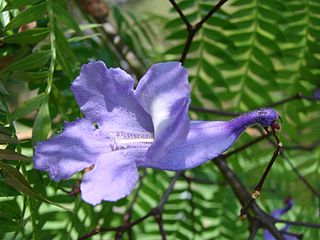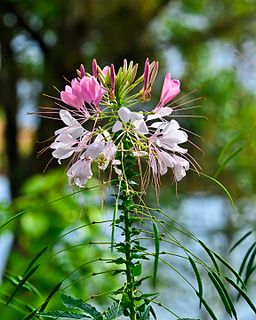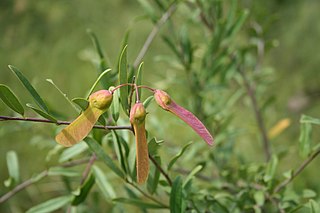
Jacaranda is a genus of 49 species of flowering plants in the family Bignoniaceae, native to tropical and subtropical regions of Latin America and the Caribbean.

Rauvolfia is a genus of evergreen trees and shrubs, commonly known as devil peppers, in the family Apocynaceae. The genus is named to honor Leonhard Rauwolf. The genus can mainly be found in tropical regions of Africa, Asia, Latin America, and various oceanic islands.

Sterculia is a genus of flowering plants in the mallow family, Malvaceae: subfamily Sterculioideae. Members of the genus are colloquially known as tropical chestnuts. The scientific name is taken from Sterculius of Roman mythology, who was the god of manure; this is in reference to the unpleasant aroma of the flowers of this genus. Sterculia may be monoecious or dioecious, and flowers unisexual or bisexual.

Bignonia is a genus of flowering plants in the family Bignoniaceae. Its genus and family were named after Jean-Paul Bignon by his protégé Joseph Pitton de Tournefort in 1694, and the genus was established as part of modern botanical nomenclature in 1753 by Carl Linnaeus. Species have been recorded from the southern USA, Central to most of South America.

Stereospermum is a genus of trees in the paleotropical clade of the family Bignoniaceae. A species of Stereospermum is used in herbal medicine in Ayurveda as well as it is an integral part of the culture and tradition of the cold desert biosphere reserve.

Cleome is a genus of flowering plants in the family Cleomaceae, commonly known as spider flowers, spider plants, spider weeds, or bee plants. Previously, it had been placed in the family Capparaceae, until DNA studies found the Cleomaceae genera to be more closely related to the Brassicaceae than the Capparaceae. Cleome and clammyweed, can sometimes be confused. The simplest way to differentiate the two is to compare the seedpods which project out or down on cleome and up on clammyweed.

Securidaca is a genus of shrubs and lianas in the family Polygalaceae. It is native to tropical Africa, SE Asia and the Americas from Mexico and the West Indies to Paraguay.

Cydista is a genus that consists of more than twenty species of lowland, showy, evergreen, ornamental shrubs and woody vines, ranging from central and southern Mexico to Paraguay and eastern Brazil. The genus is characterized by the lack of a nectariferous disk and is associated with the multiple-bang flowering syndrome. All species are lianas with clusters of funnelform flowers, blooming twice a year in spring and fall. The flowers start of purple and change to a lighter shade of lavender with age, then fading to almost white, followed by linear oblong fruits and winged seeds. The plants are multi-stemmed with opposite, oval, glossy, dark-green leaves and 2 leaflets, and climb by tendrils arise from the leaf axils. Leaves smell like garlic when crushed.

Amphilophium is a genus of flowering plants in the family Bignoniaceae, native to South America. Amphilophium crucigerum has escaped from cultivation elsewhere.

Tanaecium is a genus of flowering plants in the family Bignoniaceae, native to south and Central America.
Pleonotoma is a genus of tropical, flowering lianas located in the family Bignoniaceae.
Morisonia is a genus of flowering plants in the family Capparaceae, found across the Americas from the United States to Argentina. It was recently enlarged with New World Capparis species due to existing taxonomic instability. They tend to be shrubs or small trees.
Xylophragma is a genus of flowering plants in the family Bignoniaceae, native to dry forests of Mexico, Central America, Trinidad and northern South America. They are lianas or scandent shrubs.










